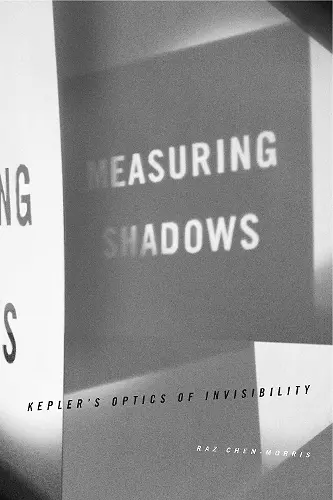Measuring Shadows
Kepler’s Optics of Invisibility
Format:Paperback
Publisher:Pennsylvania State University Press
Published:15th Nov '17
Currently unavailable, and unfortunately no date known when it will be back
This paperback is available in another edition too:
- Hardback£71.99(9780271070988)

In Measuring Shadows, Raz Chen-Morris demonstrates that a close study of Kepler’s Optics is essential to understanding his astronomical work and his scientific epistemology. He explores Kepler’s radical break from scientific and epistemological traditions and shows how the seventeenth-century astronomer posited new ways to view scientific truth and knowledge. Chen-Morris reveals how Kepler’s ideas about the formation of images on the retina and the geometrics of the camera obscura, as well as his astronomical observations, advanced the argument that physical reality could only be described through artificially produced shadows, reflections, and refractions.
Breaking from medieval and Renaissance traditions that insisted upon direct sensory perception, Kepler advocated for instruments as mediators between the eye and physical reality, and for mathematical language to describe motion. It was only through this kind of knowledge, he argued, that observation could produce certainty about the heavens. Not only was this conception of visibility crucial to advancing the early modern understanding of vision and the retina, but it affected how people during that period approached and understood the world around them.
“Raz Chen-Morris masterfully argues that Kepler’s optics is a response to widely shared anxieties about vision in Renaissance culture. This book is the first to show why the Paralipomena was important for Kepler, and how it was a book of cultural significance instead of a response to a narrowly defined technical issue.”
—Sven Dupré, Institute for Art History, Freie Universität Berlin
“Neither the disembodied mind that charted the path toward modern mathematical physics, nor the Neoplatonic magus who dreamed of hearing the music of God's celestial spheres, Johannes Kepler, in Raz Chen-Morris's erudite and multiperspectival reading, is a fully embodied early modern intellectual striving to resolve deep questions at the heart of early modern thought. Measuring Shadows is not just a new history of Kepler’s optics; it is a book about the early modern European life and preoccupations that led Kepler to his world-changing scientific achievements. As such, it is a brilliantly insightful contribution to the cultural history of early modern science.”
—J. B. Shank, University of Minnesota
“Students of the history of astronomy, science historians, and graduate-level students who are involved in the study of optics and how Kepler derived his planetary laws of motion will benefit from this work. It is also a valuable acquisition for university and college libraries and major public libraries.”
—C. G. Wood Choice
“The picture Chen-Morris paints is important because it fills out the world within which the later Scientific Revolution could emerge, and presents new questions to ask about later developments in optics and natural philosophy.”
—Elaine C. Stroud Renaissance Quarterly
“Like Kepler in the Somnium finding a way past earlier models of sense perception to visit extraterrestrial reality, Chen-Morris abandons older interpretations to present a fresh take on a familiar topic.”
—Ian Lawson Isis: A Journal of the History of Science Society
“It will be difficult to find as helpful an introduction to Kepler’s optics as the book Chen-Morris has produced.”
—Brent Purkaple Early Science and Medicine
“Presents a well-researched yet original interpretation of the relationship between science, philosophy, and the arts during several significant periods of extreme transition in an impressively aesthetic manner. It is recommended to readers particularly in the humanities, who may appreciate the author’s conceptual expression of scientific ideas, which will nevertheless not be lost on readers of a scientific background. Raz Chen-Morris’s work is both clear and, if I may say, imaginative, true to the transiting ethos of Kepler’s time.”
—Cherly Kayahara-Bass Sixteenth Century Journal
ISBN: 9780271070995
Dimensions: 229mm x 152mm x 19mm
Weight: 386g
264 pages